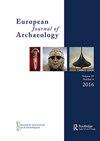Iza Romanowska, Colin D. Wren and Stefani A. Crabtree. Agent-Based Modelling for Archaeology: Simulating the Complexity of Society (Santa Fe: The Santa Fe Institute Press. 2021. xiii and 429 pp., numerous illustr., pbk, ISBN 978-1-947864-25-2)
IF 1.4
2区 历史学
0 ARCHAEOLOGY
引用次数: 0
Abstract
picture of technological knowledge and the organization of society. It does not imply social inequality, but the importance of cooperation is clearly visible. Vincǎ communities may have passed on their technological knowledge, and this flow of information is reconstructed in the direction of the Kodžadermen-GumelniţaKaranovo VI communities in present-day Bulgaria. From this point on, the task of future research is to reconstruct how this technological knowledge survives or is transformed in the next period after the abrupt end of the Vincǎ culture. After all, the period after 4450 cal BC is the heyday of the mass production of copper artefacts, with extensive formal variety. However, not enough is known about the communities of this period in present-day Serbia. We also know little about how the knowledge of metallurgical technology was integrated into the life of communities Bulgaria during the same period. Overall, the result is an impressive and convincing volume that will be indispensable in the following decades for research into the Neolithic and Copper Age of southeast Europe, as well as the beginnings of metallurgy. I am sure that Borislav Jovanovic,́ to whom this volume was dedicated, would read it with appreciation. REFERENCESIza Romanowska, Colin D. Wren和Stefani A. Crabtree。基于代理的考古学建模:模拟社会的复杂性(圣达菲:圣达菲研究所出版社,2021。第13和429页,大量插图。, pbk, ISBN 978-1-947864-25-2)
本文章由计算机程序翻译,如有差异,请以英文原文为准。
求助全文
约1分钟内获得全文
求助全文
来源期刊

European Journal of Archaeology
ARCHAEOLOGY-
CiteScore
3.40
自引率
6.70%
发文量
58
期刊介绍:
The publication organ of the European Association of Archaeologists, the European Journal of Archaeology seeks to promote open debate amongst archaeologists committed to a new idea of Europe in which there is more communication across national frontiers and more interest in interpretation. The journal accepts not only new empirical data and new interpretations of the past but also encourages debate about the role archaeology plays in society, how it should be organized in a changing Europe, and the ethics of archaeological practice. All periods are covered; papers, review articles, interviews and short "debate" pieces are all sought. Whilst English is the primary language of publication in the EJA, papers submitted in French or German will be given equal consideration.
 求助内容:
求助内容: 应助结果提醒方式:
应助结果提醒方式:


